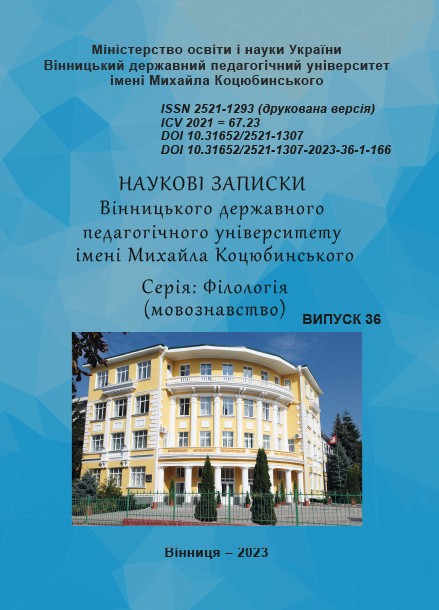Substantive-attributive formation models of secondary nominations in media texts
https://doi.org/10.31652/2521-1307-2022-36-9-21Published 2023-06-21
Keywords
- secondary nomination, lexeme, phrase, noun, adjective, Ukrainian language, mass media language, mass media
Copyright (c) 2023 Maryna Navalna, Nataliia Kostusiak, Oleksandr Mezhov

This work is licensed under a Creative Commons Attribution 4.0 International License.
How to Cite
Abstract
Introduction. The article explores the conditions for the activation of military lexemes and identifies the peculiarities of their penetration into various media texts on different topics. Among the main external factors of linguistic dynamics, the full-scale Russian-Ukrainian war is mentioned. It is revealed that a significant number of words have entered the Ukrainian information space, which have undergone an expansion of their semantic structure, acquired features of inter-thematic diffusion and new stylistic shades, opening up prospects for their multi-aspect linguistic interpretation.
Purpose. The purpose of the article is to characterize substantive-attributive expressions with the noun “front” as the anchor in the context of inter-thematic shifts, stylistic and communicative-pragmatic potential. The factual material corpus includes publications of all- Ukrainian and regional media sources for 2022–2023. The database card file contains over 1000 sentence constructions with the mentioned noun.
Methods. In order to fully interpret the functional manifestations in the language of Ukrainian mass media, to clarify the qualification-classification features, the specifics of content shifts and stylistic loading of the noun “front”, a descriptive method, observation methods and contextual-semantic analysis were used. At different stages of the research, the priority was given to the functional analysis method, which contributed to the study of the mentioned nomination in the aspect of text environment and ensured the credibility of outlining its non-specialized semantic nuances.
Results. The article describes the functional manifestations of the word “front” used in its literal sense, emphasizing that constructions with this noun typically inform about military events in eastern and southern Ukraine, rotation of our soldiers, the transfer of aid to them, etc. The “front” nomination is observed to function in various journalistic genres alongside neutral linguistic units used in a literal sense. Moreover, the analyzed word serves as a means of expressing intertextual shifts.
Originality. The scientific novelty of the article is highlighted by the detailed description of secondary nominations, modelled by noun-adjective phrases with the figuratively used base noun “front” and subordinate attributive units that specify its semantic potential (humanitarian, civil, cultural, informational, creative, artistic, musical, educational, linguistic, spiritual, psychological, economic, financial, energy, labor, agricultural, medical, sports, volunteer, culinary, gastronomic). The important qualifying characteristics of such compounds include functioning in contexts that typically inform about events indirectly related to war.
Conclusion. Two-component secondary nominations with the headword “front” are represented in various newspaper publications covering a wide range of human activity. At the same time, they demonstrate a commonality in emphasizing the unity and cohesion of Ukrainians involved in various professional spheres, as well as the understanding that everyone's work is now aimed at the common goal of defeating the enemy.
Downloads
References
- Великий тлумачний словник сучасної української мови / уклад. і голов. ред. В. Н. Бусел. Київ ; Ірпінь : ВТФ «Перун», 2005. 1736 с. URL : https://archive.org/details/velykyislovnyk (дата звернення: 15.04.2023).
- Завальнюк І., Іваницька Н. Семантична єдність повнозначних словоназв: категорійний статус та лінгвальні ознаки складових. Наукові записки Вінницького державного педагогічного університету імені Михайла Коцюбинського. Серія: Філологія (мовознавство). Вінниця : ТОВ фірма «Планер», 2022. Вип. 34. С. 9–23. https://doi.org/10.31652/2521-1307-2022-34-9-23
- Завальнюк І., Мельник Г. Жанр «теледіалог-інтерв’ю» як дзеркало мовних змін періоду війни. Наукові записки Вінницького державного педагогічного університету імені Михайла Коцюбинського. Серія: Філологія (мовознавство). Вінниця : ТОВ фірма «Планер», 2022. Вип. 34. С. 90–100. https://doi.org/10.31652/2521-1307-2022-34-90-100
- Завальнюк І. Я. Синтаксичні одиниці в мові української преси початку ХХІ століття: функціональний і прагмалінгвістичний аспекти : монографія. Вінниця : Нова книга, 2009. 400 с.
- Костусяк Н. М., Шульська Н. М., Костриця Н. М. Метафорична вербалізація концепту війна в сучасних медійних заголовках. Науковий вісник Міжнародного гуманітарного університету. Серія: Філологія. 2022. Вип. 56. С. 60–65. https://doi.org/10.32841/2409-1154.2022.56.13
- Навальна М., Калужинська Ю. Aктуалізація лексем на позначення військових дій, процесів та станів. Психолінгвістика. Psycholinguistics. 2018. Вип. 24 (2). С. 218–235. https://doi.org/10.31470/2309-1797-2018-24-2-218-235
- Навальна М., Спис О. Функційно-семантичні особливості використання війської лексики в мові газети «День». Закарпатські філологічні студії, 2022. Вип. 25, т. 1. С. 36–42. https://doi.org/10.32782/tps2663-4880/2022.25.1.6
- Параскун І. Лексичні засоби маніпуляції: емоційно-експресивна лексика. Наукові записки Вінницького державного педагогічного університету імені Михайла Коцюбинського. Серія: Філологія (мовознавство). Вінниця : ТОВ фірма «Планер», 2021. Вип. 32. С. 53–60. https://doi.org/10.31652/2521-1307-2021-32-53-60
- Прокопчук Л., Богатько В. Регіональні інтернет-видання крізь призму чинних норм. Наукові записки Вінницького державного педагогічного університету імені Михайла Коцюбинського. Серія: Філологія (мовознавство). Вінниця : ТОВ фірма «Планер», 2022. Вип. 35. С. 61–69. https://doi.org/10.31652/2521-1307-2022-35-61-69
- Navalna M., Kostusiak N., Levchenko T., Oleksenko V., Shyts A., Popkova O. Extra-Linguistic Factors and Tendencies of Activation of Military Vocabulary in Ukrainian Mass Media. AD ALTA: Journal of Interdisciplinary Research, 2022. Vol. 12, Issue 1, Spec. Issue XХV. P. 184–189. URL : http://www.magnanimitas.cz/ADALTA/120125/papers/A_33.pdf (дата звернення: 15.04.2023).





